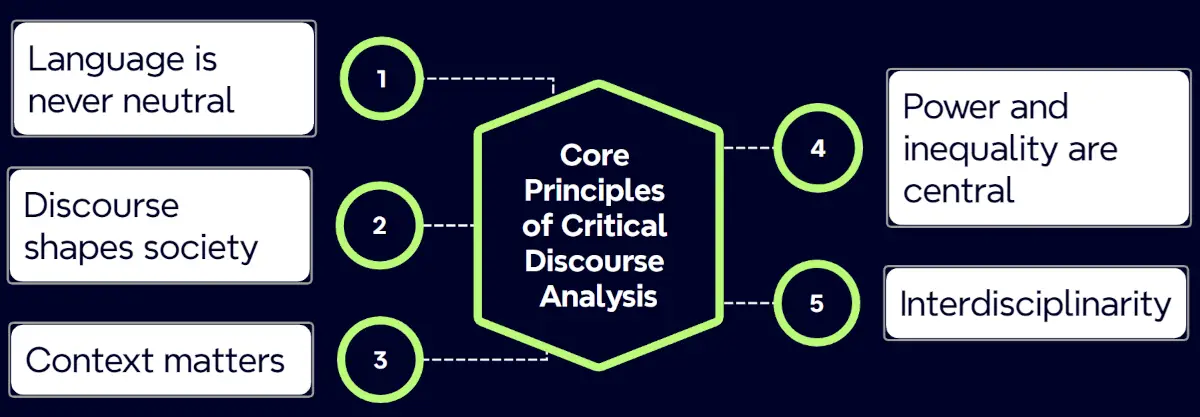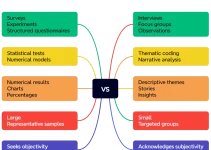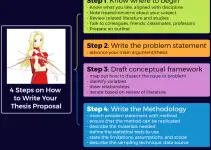This article discusses critical discourse analysis as a research method used to analyze words or groups of words to convey meaning. It is a powerful qualitative research method that can provide valuable insights. For those who prefer it over quantitative research approaches, this method is invaluable. It can also be used in conjunction with quantitative methods for a more in-depth understanding of the issue at hand.
Words are powerful—they can shape the course of human development, progress, or even disaster. Let’s see how this works.
Table of Contents
What is Critical Discourse Analysis (CDA)?
Critical Discourse Analysis (CDA) is a research method used to study how language both reflects and reinforces social power, dominance, and inequality. It goes beyond describing language—it critically examines how discourse (spoken or written communication) shapes the way we think about the world.
Critical Discourse Analysis is a research method used to study how language both reflects and reinforces social power, dominance, and inequality.
According to Fairclough (2023) and van Dijk (2015), CDA is interdisciplinary, drawing on linguistics, sociology, anthropology, and communication studies to uncover how ideologies are embedded in everyday texts and conversations.
5 Key Principles of Critical Discourse Analysis

CDA is guided by 5 core principles shared by scholars like Norman Fairclough, Teun A. van Dijk, and Ruth Wodak. These are:
- Language is never neutral – Every word choice reflects or challenges power relations and ideologies.
- Discourse shapes society – How we talk about issues (e.g., deforestation, climate change, gender roles) influences policies and attitudes.
- Context matters – CDA always considers the social, cultural, and historical context of the text or speech.
- Power and inequality are central – CDA investigates how language maintains dominance or empowers marginalized voices.
- Interdisciplinarity – CDA uses theories and tools from multiple disciplines such as linguistics, sociology, and political science.
When is Critical Discourse Analysis Used?
CDA is widely used in research and academic projects, especially in:
- Media Studies: Analyzing how newspapers or TV programs frame events or groups.
- Education: Examining textbooks and classroom language for biases.
- Political Science: Studying campaign speeches, government policies, and debates.
- Sociology: Investigating how societal power structures are maintained through language.
For students: CDA is often applied in thesis projects, discourse studies, and classroom assignments to develop critical thinking about language.
The following section shows how a full CDA study-style paper looks with introduction, method, analysis and discussion, and conclusion.
Brief Example of a Critical Discourse Analysis
Headline under scrutiny: Migrants Flood the Protected Areas
Introduction
Language plays a powerful role in shaping perceptions of social issues, particularly when it comes to contentious topics like migration. Media headlines are often the first—and sometimes the only—exposure audiences have to an event, meaning their framing carries significant weight. This paper applies Critical Discourse Analysis (CDA) to the headline “Migrants Flood the Protected Areas,” examining how its language choices reflect and reinforce power relations, ideological stances, and societal attitudes toward migrants.
Method
This analysis follows Norman Fairclough’s CDA framework, which views discourse as a social practice shaped by and shaping power structures. The headline was analyzed through:
- Textual analysis – focusing on word choice, metaphors, and grammatical features.
- Discursive practice – exploring how this headline connects to wider media and political discourse.
- Social practice – situating the headline in historical and ideological contexts to understand its broader impact.
Analysis
1. Textual Analysis
The headline’s central lexical choice, “flood,” is a metaphor drawn from natural disasters. It transforms human movement into an uncontrollable, destructive force. This choice dehumanizes migrants, stripping them of individuality and reducing them to an undifferentiated “mass.” The verb “flood” suggests urgency and threat, priming readers to perceive migration as a crisis. Replacing “flood” with neutral terms such as “arrive” or “seek entry” would radically shift the tone, demonstrating how a single word frames an entire event.
2. Discursive Practice
The metaphor of flooding is not an isolated choice but part of a broader discursive repertoire in media and political narratives about migration. Headlines and speeches often speak of “waves,” “surges,” or “invasions” of migrants. Such repetition normalizes alarmist framing, embedding the association between migration and threat into public consciousness. This headline, therefore, both draws on and reinforces these established discourses, participating in their ongoing circulation.
3. Social Practice
Historically, water metaphors have been used to describe marginalized groups and immigration flows—from “waves” of Irish immigrants in the 19th century to “tides” of refugees during wartime. These metaphors have consistently served to other migrant populations and justify restrictive measures. In the current context, “flood” evokes fears of being overwhelmed, supporting an ideology of securing boundaries of protected areas and legitimizing harsher policies against violators.
4. Power and Ideology
The headline reflects the perspective of those in power—protected area authorities, governments, non-governments organizations, and certain media outlets—who benefit from portraying migration as a threat, a justification for their continued existence or legitimacy as an institution. The migrants themselves are voiceless; their motivations, hardships, and individuality are erased. The metaphor subtly legitimizes government control and surveillance, while bolstering narratives that depict the protected areas as under siege and in need of protection.
Discussion
The CDA of this headline reveals how language is never neutral. By using “flood,” the headline actively constructs a reality in which migrants are perceived as a danger. This framing has material consequences: it shapes public opinion, influences policy debates, and fosters fear-based ideologies. Such language serves the interests of political actors who gain support for restrictive measures by portraying migration as an existential crisis.
Conclusion
The headline “Migrants Flood the Protected Areas” exemplifies how a seemingly simple phrase can encode complex ideological meanings. Through metaphorical framing, it dehumanizes migrants, reinforces power asymmetries, and perpetuates narratives of fear and control. Critical Discourse Analysis exposes these hidden dimensions, reminding us that words do more than report events—they create the social realities in which those events are understood and acted upon.
How to teach CDA
Professors typically introduce CDA in undergraduate linguistics, communication, or education courses and in graduate seminars. Teaching strategies include:
- Lectures and Readings – Foundational works by Fairclough, van Dijk, and Wodak.
- Textual Analysis Exercises – Students analyze advertisements, news reports, or social media posts.
- Class Discussions – Debates about how language shapes social issues.
- Research Projects – Graduate students often use CDA for thesis and dissertation work.
By engaging with real-world texts, students develop critical awareness of how language and power intersect.
References
- Fairclough, N. (2023). Critical discourse analysis. In The Routledge handbook of discourse analysis (pp. 11-22). Routledge.
- Van Dijk, T. A. (2015). Critical discourse analysis. The handbook of discourse analysis, 466-485. John Wiley & Sons, Inc.
- Wodak, R., & Meyer, M. (2009). Critical discourse analysis: History, agenda, theory and methodology. Methods of critical discourse analysis, 2(1), 1-33. Sage Publishing.



